Introduction
With these goals in mind, one should plan a herd-health program that focuses on:
Such a program should focus on prevention of problems through dry cow management, administering appropriate treatments in the early postpartum period, minimizing weight loss in the postpartum cow, using controlled breeding programs after the voluntary waiting period, and treating repeat breeders with appropriate therapy.
Healthy Cows Reproduce Well
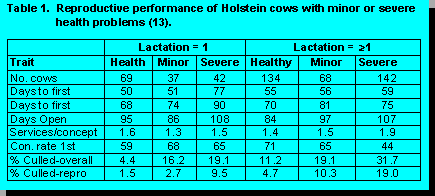
Keeping cows healthy after calving requires a management program during late-lactation and a dry cow program that focuses on maintaining appropriate body condition, preventing common diseases associated with the dry period and calving, and promoting a smooth transition from the dry period to lactation.
Management During the Dry Period
Making the Nutritional Transition
Dry cows should be offered some of the fresh cow ration before calving to enhance DMI postpartum. Fresh cows should be fed a ration to stimulate appetite. The goal should be to have the fresh cow consume as much DM as possible as soon as possible after calving. This prevents excessive body weight loss which delays resumption of postpartum cycles (5, 6) and lowers fertility during the breeding period (3, 4). Hutjens recommends that fresh cows be fed slightly differently than cows that are beyond the fifth week of lactation (Table 2), and he recommends the following practices for feeding fresh cows (11):
Notice that the fat levels (Table 2) are lower in the fresh cow diet than in the diet to be fed
after the third to fifth week of lactation. 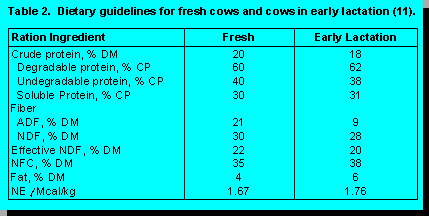 Although addition of fat to rations increases
energy density, it also depresses appetite, and for fresh cows, intake is greater if fat
supplementation is limited. Once cows are eating more vigorously, then addition of fat is
recommended for high producers. Balancing degradable protein with non-fiber
carbohydrate and energy will maximize intake.
Although addition of fat to rations increases
energy density, it also depresses appetite, and for fresh cows, intake is greater if fat
supplementation is limited. Once cows are eating more vigorously, then addition of fat is
recommended for high producers. Balancing degradable protein with non-fiber
carbohydrate and energy will maximize intake.
Reproductive Management Around Calving
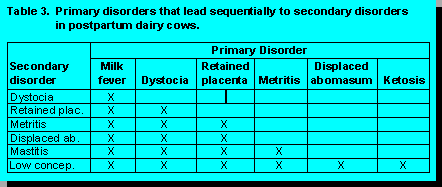
Regardless of how well cows are managed during the dry period, if they are not provided with a good environment at the time of calving, they are likely to experience postpartum health problems that will lower milk yield and reproductive performance. Cows should be calved outside in a dry area if weather permits. Otherwise, cows should calve in a well-bedded box stall or on a bedding pack. Straw is the preferred bedding in the calving area because it absorbs more moisture than other bedding materials and because its larger particle size minimizes its potential uptake into the reproductive tract.
Calving problems, abnormal discharges after calving, and poor health in general during
the periparturient period prevent the reproductive tract from involuting properly. Poor
uterine involution leads to reduced long-term reproductive performance. For example, we
(12) noted that cows with abnormal discharges during the first two to three weeks after
calving were more likely to have a medium
or large cervix at the postpartum exam than cows that were normal (Table 4) . When the process
of involution was slowed, the consequences were manifested as poor reproductive performance
several weeks later during the breeding period (Table 5).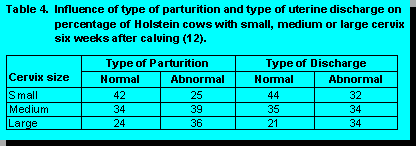
Getting Cows Off to a Good Start After Calving
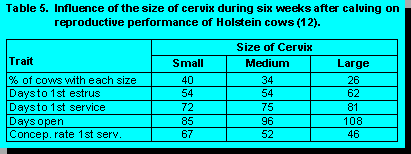
Cows that experience severe substantial losses in body condition during the postpartum period may begin to cycle normally, but still experience low fertility during the breeding period (3, 5, 6). There is evidence that ovarian follicles in early stages of development (50 to 80 days prior to ovulation) may be impaired by development during a period when negative energy balance leads to an alteration in the levels of growth factors (3, 4).
Treating Postpartum Disorders
![]() Retained Placenta
Retained Placenta
There is some evidence that long-acting prostaglandin agonists will reduce the duration of placental retention if administered during the first few hours after calving (10). The mechanism of such action is unclear, particularly when one considers that uterine levels of prostaglandin are high during this period of time. Potentially, the prostaglandin could eliminate residual progesterone from a CL that had not completely regressed prior to delivery, but if this was the mechanism, then one would expect shorter-acting prostaglandins to be effective. In general, the literature in this area is too inconsistent to recommend the routine use of prostaglandin agonists after calving, except in certain situations such as with induced calving, where the incidence of retained placenta would be expected to be high.
![]() Dystocia and Metritis
Dystocia and Metritis
Administration of prostaglandin F analogues at one or two weeks postpartum or GnRH at two weeks postpartum may be beneficial for initiating estrous cycles and reducing interval to first service and days open (7, 14). This benefit has been seen in field trials when cows were treated routinely (Table 6), but such treatments may be most beneficial for cows that experienced dystocia or other problems at calving (Table 7). Recent field trials have indicated that prostaglandins alone are probably as effective as the GnRH-prostaglandin combination (Table 7). In general, cows that have more cycles by the beginning of the postpartum breeding period are more likely to conceive at first service and require fewer services per conception than anestrous cows (18). So the effect of PGF and GnRH in cows with dystocia and retained placenta may be primarily through the earlier cyclicity and better uterine involution associated with recurring estrous cycles.
![]() Cystic Follicles
Cystic Follicles
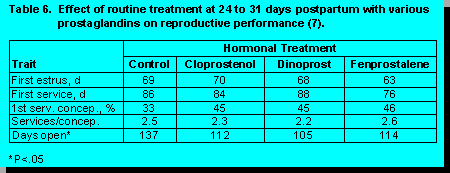 GnRH or human chorionic gonadotropin
(hCG) are the accepted treatments for ovarian follicular cysts, and there does not appear to be a
major difference in their efficacy. Luteinized cysts will regress in response to PGF, but the ability
to detect whether a cyst is luteinized or not based on palpation alone varies considerably. Cowside
progesterone tests may be useful for determining whether a cow is likely to be responsive (1).
GnRH or human chorionic gonadotropin
(hCG) are the accepted treatments for ovarian follicular cysts, and there does not appear to be a
major difference in their efficacy. Luteinized cysts will regress in response to PGF, but the ability
to detect whether a cyst is luteinized or not based on palpation alone varies considerably. Cowside
progesterone tests may be useful for determining whether a cow is likely to be responsive (1).
![]() Repeat Breeders and Early Embryonic
Death
Repeat Breeders and Early Embryonic
Death
Quite a number of studies have shown that conception rate in repeat-breeder cows (third
or later service) can be enhanced by treatment with GnRH at insemination (17). The
mechanism through which GnRH induces its effect is probably associated with altering
progesterone secretion by the corpus luteum rather than by stimulating ovulation, because
treatment with GnRH consistently improves fertility in repeat breeders whereas double
insemination does not (17). If delayed ovulation was a problem in repeat breeders, then
double insemination should be beneficial. One must determine whether the increase in
conception rate (about 15% overall) associated with GnRH treatment of repeat breeders
is worth the extra investment. There also is evidence that treatment of repeat breeders
with low doses of hCG to increase progesterone level my be beneficial and the cost of the
latter treatment may be more favorable. 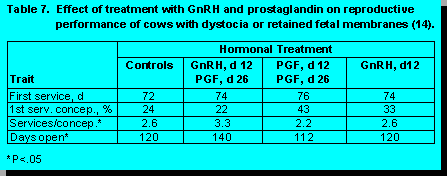
Embryos that die after the second week of pregnancy cause cows to show a delayed return to estrus (4). It is estimated that 7 to 12% of embryos die after the second week of pregnancy (4), and typically these cows will have return intervals of 28 to 35 days (4). This return interval is not a multiple of that which would be expected from missed heats, but a careful examination of heat detection records is needed to distinguish between errors in heat detection and embryonic death. Little is known about causes of early embryonic death, but factors such as excess intake of degradable protein and ingestion of mycotoxins may be involved. There are no clearly effective procedures for preventing early embryonic death except in cases where dietary or environmental conditions are the cause.
Programmed Breeding
Another programmed breeding strategy is to batch cows so that breeding occurs during one week out of three (2). In this scenario, cows that do not conceive at first service exhibit there repeat heat at the time of first service for the next batch. This can substantially reduce the effort devoted to heat detection and insemination without lowering herd reproductive performance.
There is a high correlation between days to first service and days open. Thus, the best way to reduce days open is to breed cows as soon as possible after the end of the voluntary waiting period. While there is a modest increase in conception rate up to about 100 to 120 days postpartum, the higher conception rate does not offset the days lost because of failure to inseminate cows. Even at highest levels of production, it is still recommended to aim for calving intervals of 12 to 13 months.
References